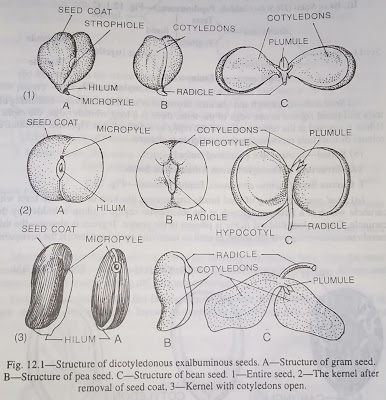Structure of Dicotyledonous Exalbuminous Seeds
1. GRAM SEED (Cicer arietinum, Papilionaceae)-Gram seeds are broader at one end and pointed at the other end i.e. they are more Or less triangular in outline.
(a) Seed coats are two and distinct-outer testa and inner tegmen. Testa is brownish
in colour, thick and leathery whereas inner tegmen is whitish, thin papery and adherent to the testa.
On one side of the projected end, there is a scar showing the position of stalk attachment which is the hilum and very near below the hilum a small triangular pore is seen-this is the micropyle, the ridge present on the testa is the strophiole.
(b) Kernel-On removing the seed coat it is obtained. In this type of seed kernel is the embryo which consists of two thick fleshy (i) cotyledons and (ii) an axis or tigellum. Cotyledons are attached to this axis. The upper end of the axis with crowded immature leaves is the plumule (gives rise to shoot) and the lower end lying towards the pointed end of the seed is known as the radicle (gives rise to root). The point of attachment of the cotyledons to the axis i.e. tigellum the first node (i.e. cotyledonary small portion of the axis just below the cotyledonary node i.e., between the node is called the hypocotyl and similarly the small portion just above the cotyledonary node i.e. between the node and the plumule is called the epicotyl.
II. PEA SEED-
(a) Seed coat-Consisting of outer whitish tough testa and inner thin delicate membranous, hyaline and non-separable (at mature condition) tegmen.
A narrow elongated scar-like structure, called hilum is present on one side of the testa showing the remnant of stalk attachment, and very near to hilum, a small pore is seenthis is the micropyle. A short ridge is present along the hilum which is the raphe.
(b) Kernel-This is a whitish fleshy body visible on removing testa-it is the embryo proper and consists of (i) two cotyledons and (ii) an axis-the upper part of which is the plumule and the lower part is the radicle. Epicotyl and hypocotyl are like that of gram seed.
III. BEAN SEED (Dolichos Iablab, Papilionaceae)-
(a) Seed coat-It is tough and blackish, brownish or reddish in colour-consisting of testa and fused tegmen at one edge of the testa, there is a long whitish ridge, the raphe Hilum is situated at the lower portion of the raphe as a distinct scar. Opposite to hilum, a minute distinct hole representing the micropyle is situated.
(b) Kernel-as usual like gram seed

Comments
Post a Comment